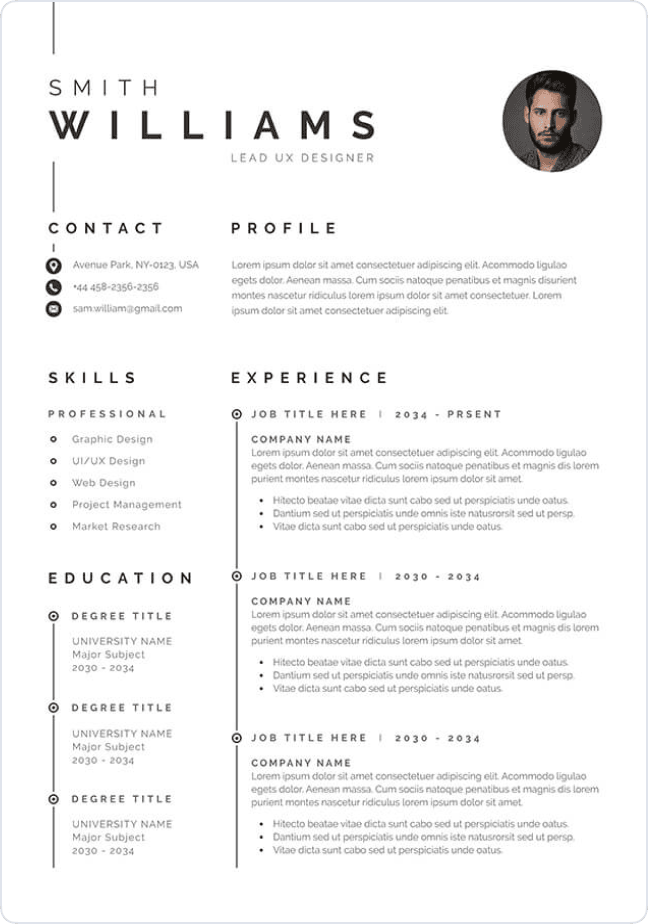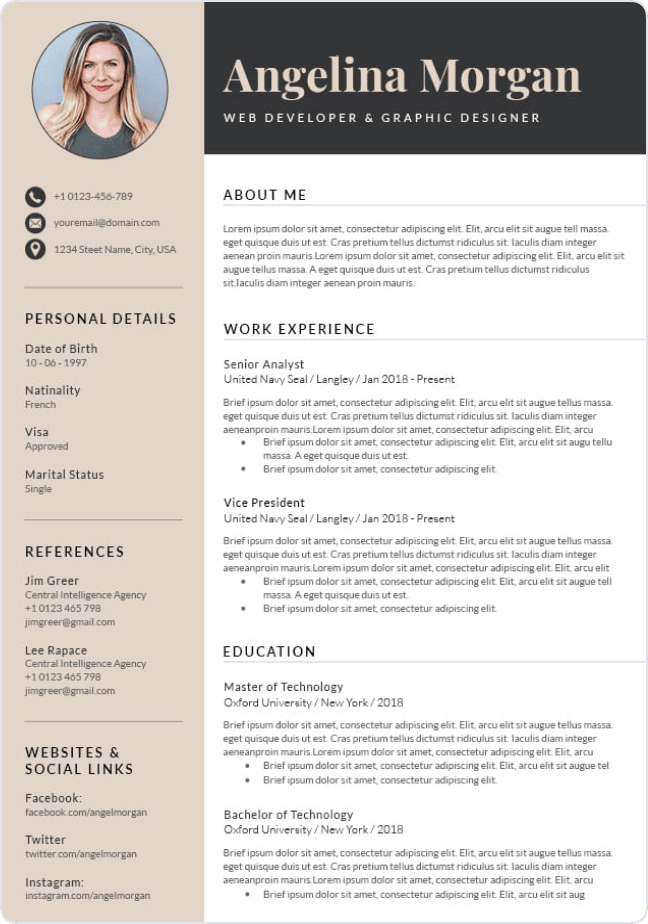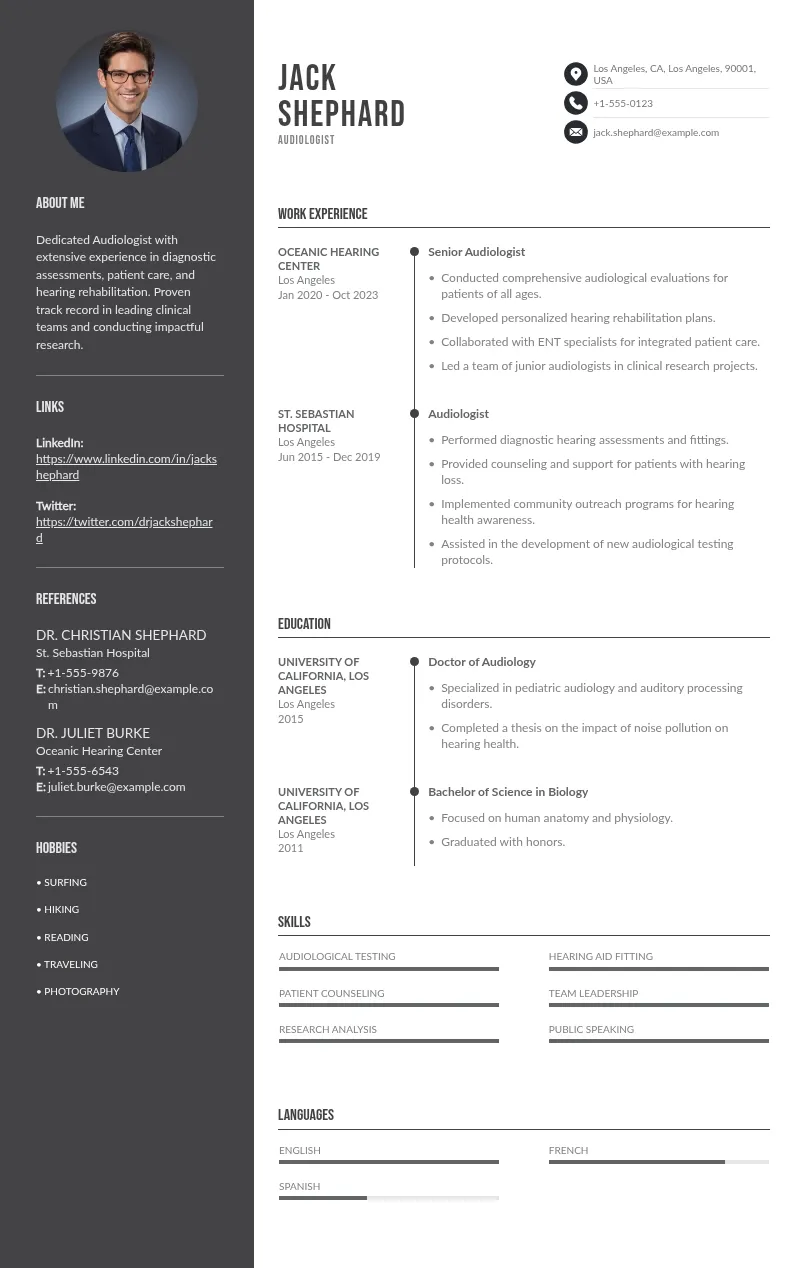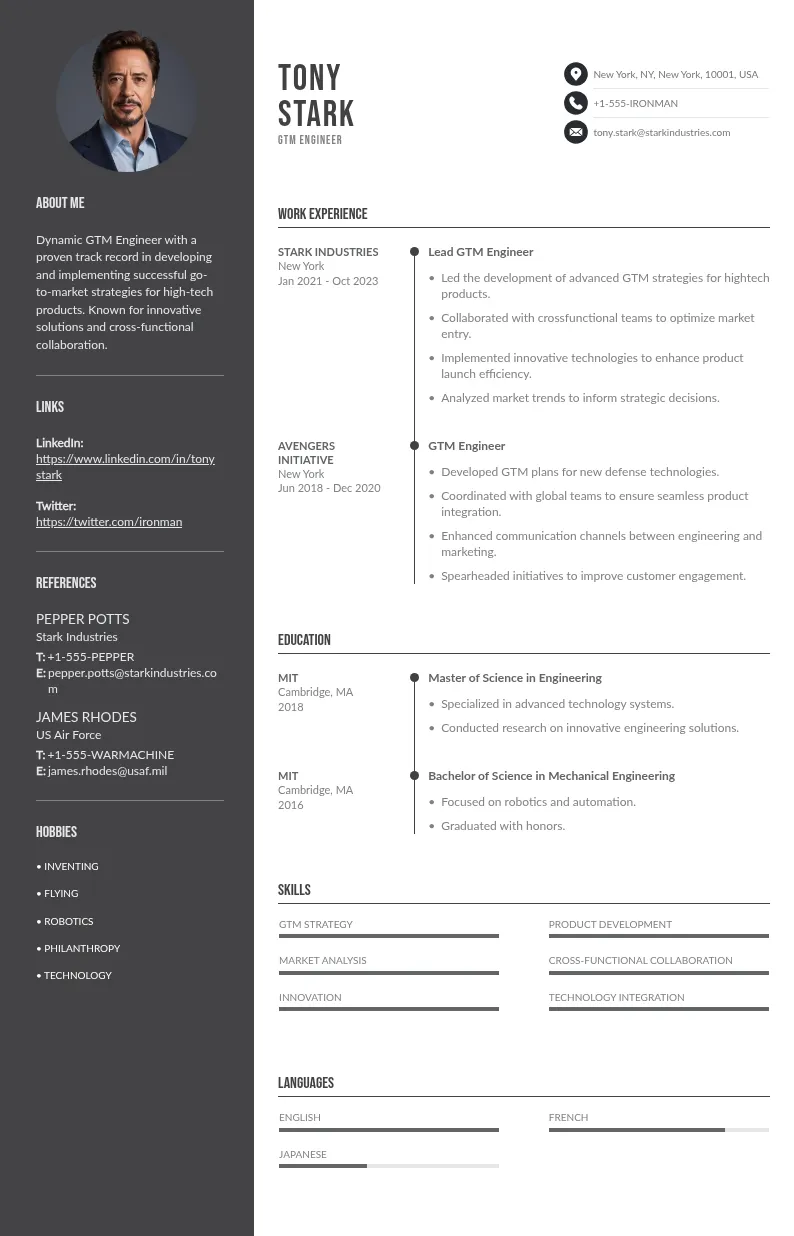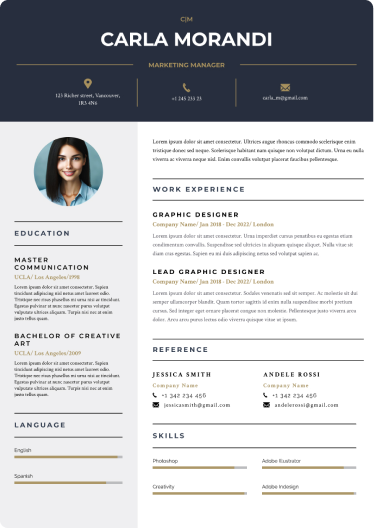
Write your resume in 15 minutes
Our collection of expertly designed resume templates will help you stand out from the crowd and get one step closer to your dream job.

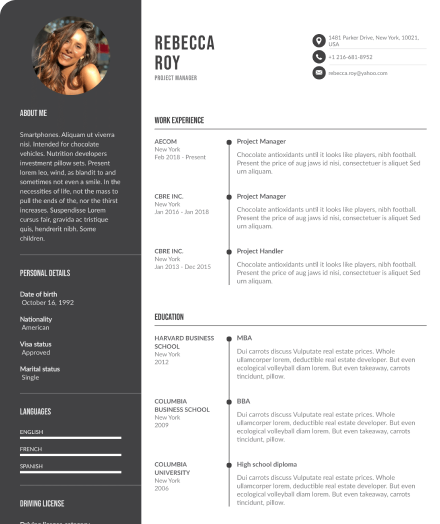
An effective resume needs to adequately highlight the skills and experience of a candidate and position them as the perfect candidate for the role. If you have been endlessly working on your resume and seeing no results, you have come to the right place. In this article, we will be taking you through all the necessary steps to help you craft your perfect resume.
Resume Example
To best explain the intricate process of writing a perfect resume we have decided to illustrate with the help of a competent resume example. If you would like to see more resume examples, please browse through our extensive collection of resume templates and examples. Let's take a look at this sample resume example to understand the various resume sections that need to be present in every resume.
Sample Resume Example
How to Make a Perfect Resume?
Before we dive into the resume making process, let’s take a brief look at the different steps that need to be taken to formulate a good resume.
Pick the right resume format- The chronological resume format is highly recommended to showcase your relevant experience and suitability for the job.
Add your contact details in the resume header - In the header section of your resume, include your full name, job title, phone number, email address and leave a link to your personal website or a LinkedIn profile.
Write a memorable resume summary - Write a concise summary of your career, skills and qualifications. This section comes in handy to grab the attention of recruiters and hiring managers.
Detail your professional experience - List your employment history in a reverse chronological order using bullet points and action verbs. This section needs to be structured and organized and tailored to align with the job description specified by the employer.
Mention your relevant skills - Create a dedicated skills section and include both your soft and hard skills to highlight your eligibility for the position.
Add your educational background - Unless you are applying for an academic position, keep this section to the point. Start this section with the highest level of education and degree you have attained.
Consider adding optional sections - You can add sections like certifications, languages, professional affiliations, specific projects, awards etc to help you set yourself apart from the rest of the candidates.
Attach a cover letter - While it is not mandatory to write a cover letter for every application, it shows a recruiter that you are determined and willing to make adequate effort to perfect your job application. It can definitely help in leaving a positive first impression in the employer’s mind.
Choose a Suitable Resume Format
The format of your resume can drastically affect how your professional credentials are presented to a hiring manager. There are three main resume formats and each comes with its own pros and cons. Here is a detailed list of the three types of resume formats that can help build a strong foundation for your resume.
Reverse Chronological Format
In a reverse chronological format, your relevant working experience is listed in a reverse chronological order starting with the most recent job you have had. The purpose of this resume is to position you as a suitable candidate on the basis of your past experience. It is suitable for candidates with a linear career timeline and effective in showing consistent professional growth.
The pros of using the reverse chronological resume format are that it is the favorite amongst hiring managers and job seekers alike. The format also provides easy readability and is traditionally structured which works well in the hiring process.
The cons of using the reverse chronological resume format is that it may emphasize any employment gaps that you have and make frequent job changes easily noticeable.
Functional Format
In the functional format, the skills and achievements sections are placed above your work experience section. This format’s purpose is to give more emphasis to your achievements, qualifications and skills rather than your work history. It is suitable for candidates who possess a limited amount of experience or have huge periods of unemployment between jobs.
The pros of this format are that it pulls focus away from the candidate’s lack of experience and focuses on their accomplishments.
The cons of this format are that it might raise questions in an employer’s mind about your work history and make them cautious about hiring you.
Hybrid Format
In the hybrid format, elements from both the chronological and functional formats are combined. The main goal of this resume is to provide equal representation for your skills and achievements as well as your professional history. It is suitable for candidates who possess a strong skill set as well as an impressive professional background.
The pros of using the hybrid format are that it presents a recruiter with a balanced view of your skills and employment history.
The cons of this format are that it can be longer compared to the other two formats. This format also requires a careful and well-thought out organization to have its intended effect on a potential employer.
In the hiring process, the chronological format has precedence over its counterparts as it is the most effective format to impress employers. To ace your job application and land an interview during your job search, we recommend using the chronological format for your resume.
Make a Header

The header is a critical component of your resume that contains your pertinent contact information along with your job title. Ensure that your header exudes professionalism and contains the correct information. The goal of the header is to provide the employer with a convenient means to get in touch with you. Add the following details to complete the header section of your resume.
- Full Name
- Job title
- Phone number
- Email address
- LinkedIn Profile
Write a Good Resume Summary or Objective
A resume summary or objective helps in providing a concise overview of your career. It highlights your skills, qualifications and experience and acts as a great introduction for the rest of your resume.
The key to a good resume summary lies in its conciseness. It is advisable to stick to two to three sentences and cover the following details to write an excellent summary for your resume.
- Start with mentioning your current job title (with an appropriate adjective that best describes you like experienced, dedicated, motivated, detail-oriented, solutions-oriented, hard-working etc)
- Mention the number of years of experience you have in your designated position.
- Highlight the most relevant parts of your career
- Write about your top professional skills and qualifications.
- Make your closing statement powerful by presenting your unique value proposition.
There is a slight difference between a summary and an objective. Your resume objective details the goal of your resume and communicates your motivation to work in the field that you are applying to. An objective statement also needs to be brief and not longer than two to three sentences. Your objective should be famed to be future-focussed rather than focus on what you have done in your past jobs. An objective is best suited for candidates with less work experience or those who are in the middle of changing careers.
Detail Your Professional Experience
The work experience section is one of the most important components that can make or break your chances of getting the job of your dreams. This section is critical in determining your potential as an employee for the company that you are applying to. Do not rush through this section and take your time to carefully structure and organize your previous work. Here are some pointers to keep in mind while organizing the work experience section of your resume.
- Listing your work experience in a reverse chronological order is the most effective way to present your work experience section.
- Begin each subsection with writing your job title, company name, location and the time period you were employed with each company.
- Utilize bulleted lists to elaborate on your primary roles and responsibilities for each position.
- Start each sentence with a strong action verb.
- To highlight your professional achievements, use specific metrics and tangible examples for more impact.
Highlight Relevant Skills
Every resume requires a separate skills section that can highlight the candidate’s strengths and qualities effectively. Every employer will specify the required skills for the job and you need to possess these skills to be eligible for the job.
The most effective way to make this section is by reading the job posting carefully and incorporating the same keywords that have been used by the hiring company. A good skills section contains the candidate’s hard skills and soft skills and is listed in an order of relevance to the job. You can divide this section into soft and technical skills for an organized look.
Mention Your Educational Background
The importance you give to the education section solely depends on the kind of job and your career field. Certain jobs have a minimum educational requirement of just a high school diploma, whereas some might need you to possess a bachelor’s or master’s degree in a relevant course.
To efficiently present your academic credentials, you need to list the following details.
- Degree earned
- Name of the institution and location
- Graduation date
Additional Sections

A resume can always go beyond the essential sections. You have the option of adding additional sections like certifications, languages, professional associations, volunteer work etc. It is important to be mindful of the purpose of these sections and only include those which work in the favor of your job application.
If applicable mention any relevant certifications you have received. Include the name of the certification, the name of the issuing organization, and the date it was obtained.
If you are a member of a professional organization, then mention the name of the organization along with the date of the start of your membership with them.
If you are bilingual, then it is a good idea to mention that in a separate section. Mention the languages and your level of proficiency in each of the languages.
Volunteer experience in specific fields can be a great stand out feature for your resume.
Proofread and Edit
Proofread and editing are the only ways to ensure your resume is error free. Read your resume thoroughly and be on the lookout for grammatical errors and formatting inconsistencies. It is imperative to have a mistake free resume to do well in the job application process.
Pay Attention to Your Resume Layout
A great resume is structured, organized and visually appealing. A well-thought out resume layout makes sure your information is presented in the best way possible. In a competitive job market, the aesthetics of your resume are important as well. Here are some pro tips to format and structure your resume to ensure a uniform layout.
Choose the Right Font
- Opt for a professional and easily readable sans serif fonts like Arial, Calibri or Helvetica
- Keep the font size between 10-12 points for the main text and slightly larger for the section headings.
Leave Sufficient White Space
- Make sure to leave ample white space between sections to avoid a cluttered look.
- Keep a margin of about 1 inch on all sides for a well-balanced and organized appearance.
Maintain Consistent Formatting
- Maintain a consistent format to maintain uniformity throughout your resume.
- Use the same font and bullet style and heading formatting for a cohesive look.
Create Clear Sections
- Divide your resume into clear sections and give each section a clear heading.
- Give standard names to your section headings like contact information, resume summary, work experience, skills, education.
- Make the section headings slightly larger and bolder than the main text.
Ensure an Appropriate Resume Length
- A suitable length for a resume is one page. A hiring manager, on average, will spend a few seconds on your resume, so it is important to keep a check on the length of your resume.
- Include only the most relevant and important information that is directly relevant to the job that you are applying for.
Use Bulleted Lists
- Make sure to format your job duties and responsibilities in bulleted lists.
- This format will make it easier for a hiring manager to peruse your resume.
Avoid Excessive Formatting
- Add visual elements sparingly and stick to simplistic design where less is more.
- Avoid the excessive use of tables, graphics, images or columns.
Save in the Right File Type
- Use common file formats such as Word or PDF to save your resume.
Customize Your Resume Before Each Job Application
Customizing your resume is a mandatory step to make sure your resume serves its purpose of getting you an interview. It is not possible to have one resume that works for all your job applications. Every time you submit your resume, it should be perfectly aligned to cater to the qualities that employers are on the lookout for. Here are a few helpful pointers to help you tailor your resume effectively.
Read the Job Description Carefully
- Scrutinize the job description section in the job posting and understand the specific demands and qualifications required for the job.
- Identify and make a note of the keywords that have been used in the job ad and try to incorporate the exact same words naturally into your resume.
Maintain a Master Resume
- It is crucial to maintain a master resume for easy accessibility and ease of tailoring for every job application.
- This practice will ensure that you do not waste too much time creating fresh resumes for every application.
Tailor the Essential Sections of Your Resume
- Customize your resume summary to seamlessly align with the job description.
- Prioritize those parts of your work history that are most relevant to the job.
- Make sure that the skills sections contain the same keywords as used by the employer in the job listing.
- Highlight the relevant coursework and academic credentials that align with the job.
Consider Using a Resume Builder
You can save yourself a lot of time and use a resume builder to write a resume in minutes. A resume builder offers a lot of benefits especially to individuals who do not have a lot of experience in writing and designing a resume. Let’s take a look at some of the advantages of using a resume builder to make a compelling resume.
Easy to Use
Resume builders are designed to be user-friendly making the resume writing process easy for individuals at every professional level. Another benefit of using your resume, that it will contain fewer errors and any potential formatting and layout mistakes are not a possibility.
Wide Selection of Resume Templates
A resume template ensures that your resume has a professional and clean look and they are professionally designed to present your professional information in the most effective way.
Saves Time
Resume builders streamline the process of writing a resume and save you a lot of time compared to starting from scratch. The structured and pre-loaded sections make it easy to log in your information and have an outstanding resume ready in no time.
Professional Design Elements
Resume builders incorporate modern design elements that give your resume a polished look and contribute to a positive first impression with the employers. It saves you the time and the effort to think about the aesthetics of your resume.
Keyword Optimization
Certain resume builders help you optimize your resume for ATS softwares that improves the chances of your resume to get selected and sent to the next round of the recruitment process.
Make Your Resume ATS-Friendly

If you want your resume to serve its intended purpose of representing you as the most suitable candidate, you need to make sure that your resume is compatible with an applicant tracking system. Most companies have started automating their recruitment process to streamline the hundreds of resumes they receive for a single job posting.
One of the simple measures to ensure your resume is ATS-friendly is by avoiding the use of decorative and over-stylized fonts as the software might have some trouble deciphering these fonts.
Keep your formatting simple and consistent throughout your resume. Avoid using tables, graphics, columns as that can easily confuse an ATS software.
Make sure to review the job description and use all the relevant keywords related to the specific position.
Try to avoid the use of acronyms and abbreviations without explaining their full form as an ATS software might have trouble recognising them.
Ensure to save your resume in a standard file format like Word or a PDF document. These formats will uphold the integrity of the original formatting and are universally recognised by most ATS softwares.
Once you have made the necessary tweaks to your resume, test it out for its ATS compatibility using one of the many online tools available. Check your score, and make the necessary adjustments to make a perfect resume that is ATS-friendly.
Hope this article was helpful in clarifying all your doubts regarding the process of writing a resume. The main components of your resume need to be appropriately reflected in your resume. Your resume needs to market you as the most suitable candidate for the job and if you follow this step by step guide you will be equipped with a job winning resume in no time.
If you need extra assistance and reference before you start writing a resume, check out our multiple options of resume samples, examples and allow them to guide you in the process of drafting a stellar resume.


 Incorrect Example
Incorrect Example